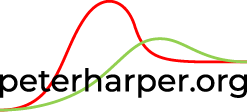Exhibitions
From time to time I have created complete exhibitions, usually in partnership with others.
During my term as Display Co-ordinator at CAT, 1988-95, I was in effect a full-time exhibition designer. The first example is a specimen of my work at CAT.
What it would be like to encounter a mole, if you were the size of a worm...
The MOLE-HOLE,
CAT, 1995
The possibility of an ‘underground experience’ had been discussed at CAT since the late 1980s. It was intended to be one of the main new displays during the ‘Gearchange’ process of 1990-92, but was cancelled for lack of funds. In 1994 a bequest offered CAT £21,000 for a new display, and it was decided to commence what became known as the Molehole.
I was the overall designer, with colleague Clive Newman building the structure. My concept was ‘life underground at different scales’. This had two aspects: a dark tunnel with small ‘caves’ and tactile surfaces giving an experience of what it might be like to live underground; and (within the tunnel) a series of dioramas showing underground organisms at different scales.
The dioramas consisted of highly realistic clay and fiberglass models, created by an Rosemarie and David Cooke, an unusual mother-and-son team of sculptors who specialise in biological exactness. I specified four scales, x10 (worms, beetles), x100 (mites, springtails), x1000 (protozoa) and x10000 (bacteria). These were painted and assembled into dioramas by my colleague John Urry.
The forest floor diorama, with ground beetle, ants, earthworm and cockchafer grubs
The exhibit was finished on time and on-budget, and opened by the naturalist David Bellamy in 1995. It has remained a memorable feature of the displays at CAT.
Draft floor plan for a bilingual exhibition on environmental technology (in Swedish For en Teknik i Folkets Tjanst) eventually realised in an annex of the Modern Art Museum on Skeppsholmen, an island in the Stockholm archipelago, during the UN Conference on the Human Environment in the summer of 1972. The 'curators' were continuously on hand, and visitors were encouraged to engage in dialogue or make their own contributions. The exhibition could be considered a fore-runner of CAT and many other environmental demonstration centres.
TOWARDS PEOPLES TECHNOLOGY/FOR EN TEKNIK I FOLKETS TJANST
Museum of Modern Art, Skeppsholmen, Stockholm, 1972
I was invited to create an exhibition of environmental technology to coincide with the UN Conference on the Human Environment of summer 1972. I was assisted by numerous colleagues, notably the engineer Björn Eriksson, the architect Varis Bokalders.
This is a rare photo of Peter Harper at the exhibition in Stockholm, wearing the ubiquitous 1970 eco-face
Funds were very limited, and the exhibition was something of a ‘work in progress’. Its main feature was interactivity, with discussion corners in various parts of the exhibition space and ‘manifestoes’ on the walls as well as many exhibits, which included solar panels, model wind turbines, a biogas digester, a Stirling engine, experimental bicycles, advanced windows, wood stoves, a ‘model village’ and so on.
THE ART OF COMPOST
Southport Flower Show, 1996
CAT was offered a fee of £5000 and its own marquee to mount an exhibition during the annual Flower Show (the ‘Chelsea of the North’) with the theme of ‘Gardening in the Future’. We decided to create a sculpture exhibition with lifelike models of compost and ‘decomposer’ organisms on plinths, with explanatory texts, while at the same time allowing visitors to examine real compost samples with hand lenses and binocular microscopes, and see many of the organisms alive. There were also regular workshops on compost making.
The models were made by the same mother-and-son team, Rosemarie and David Cooke, that had created the models for the Molehole. They included a springtail, a mite, a worm, a devil’s-coach-horse beetle, a toadstool, an actinomycete, a bacterium and so on. The exhibition was very successful and much remarked on as a haven of quiet realism among the crass commercial din.
21 OBJECTS SYMBOLISING SUSTAINABILITY
Guardian Hay Festival, 2008
On the occasion of the Hay Festival’s 21st anniversary we were invited to install around the site, 21 objects each with a story that together symbolised the sustainable future. I chose them, mounted them and wrote their ‘stories’. More here. Many people found the objects – and their stories – surprising. Here are some:
A tree
A mirror
The UN flag
Electric-assist bicycle
A three-legged stool
A hemp-lime block
Real musical instruments
A photovoltaic panel
A grandmother
Smart meters
A garden fork
A power cable
Welsh Champagne
EXHIBITION AT RADICAL TECHNOLOGY II CONFERENCE
The original book Radical Technology was published in 1976. In 2016 a 40th-anniversary event was held in Bristol (www.radicaltechnology.org). Many items contemporary with the original were displayed, and I wrote short descriptions putting them in context.
Annotations for Documents (Word)
We also showed a retrospective collection of the work of the anarchist artist Cliff Harper, again with my own annotations. Cliff had contributed iconic and highly influential drawings to the original volume, such as the one below. These were based on sketches which I and Godfrey Boyle provided in 1975, which Cliff brought dramatically to life.
Cliff also started on a cycle of illustrated comic books called Class War Comix, before embarking on the Radical Technology Visions. He only completed one, called New Times. It is a direct view into the anarchist and libertarian politics of the time, shown on a video loop in the Exhibition. It is too large a file to attach here, but you can download it from
http://www.radicaltechnology.org/wp-content/uploads/2017/03/Class-War-Comix-Clifford-Harper.pdf
The cover gives the flavour….





